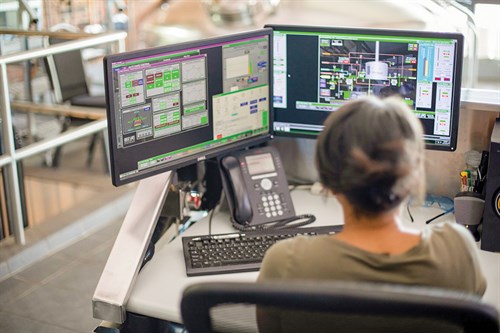Interchangeable skids minimize downtime in gas processing plants
Natural gas production is expected to steadily climb in the coming decades, increasing by up to 59% by 2050.1 Companies that help build the infrastructure required by this greater level of global production will be poised for success.
One such companya was tasked with a substantial integrated turnkey project in the U.S. The company was contracted to design and fabricate five gas processing plants for a U.S. natural gas producer. A major requirement of the project included incorporating interchangeable skids that could be moved or reused across all five plants with minimal downtime.
A five-facility rollout. Gas processing systems separate liquids from natural gas. The natural gas is pumped in from the ground and refrigerated, which causes the liquids and gas to separate. The liquids are then sold, while the gas is recirculated and reused in the process.
Given the scope of work, the five plants were each designed with a main station control center, where plant operators would centrally monitor and control operations and where the distributed control system (DCS) and motor control center (MCC) were housed.
The gas processing operation itself would run using inlet, refrigeration and overhead skids. The inlet skids (where the gas first comes into the plant) ensure that pressure and volume levels are correct and consistent for the facility. Refrigeration skids cool the gas to the temperature needed to separate the liquids. Overhead skids provide process redundancy by adjusting pressure levels if other skids fail to make the necessary changes.
These skids, however, would only be considered a success if they could freely move around, within and across plants with minimal reconfiguration. Thus, it was critical to have a control and information architecture in place that would allow for near-seamless plug-and-play skid connectivity.
Designing for plug-and-play. Network design best practices were combined with new network and control technologies to maximize not only connectivity, but also performance and efficiencies in these plants. Converged plantwide Ethernet guidelines helped the team develop an optimal network architecture.
The network architecture in each facility was segmented into multiple subnets for each device type function, which would allow for better management of traffic. Industrial Ethernet-managed switches were deployed as gateways to route traffic across the different segments. The use of segmentation, a security best practice, also allowed third-party devices to be segregated from the main control network.
A device level ring (DLR) network topology was used within each skid, as well as to network all skids together in each plant. Embedded Ethernet switches were used to bring any single-port devices onto a DLR. The embedded Ethernet switches were also used as media converters for skids that were too far from the controllers, requiring fiber instead of copper to reach them.
Central to the plug-and-play connectivity were network address translation routers (NATRs). These devices allowed machines—like the skids in these five plants—to be added, moved or replaced with little to no configuration.
High-performance controllers were used for each plant’s station control and on each skid. Each skid also uses versatile human-machine interface (HMI) software that enables machine-level operator interface devices (FIG. 1). The software provides alarm and shutdown information, as well as pressure, temperature and other process data. All this information is available to operators at the main station control through a plantwide visualization software.
 |
|
FIG. 1. The skids use versatile, plantwide, HMI software that provides alarm and shutdown information, as well as pressure, temperature and other process data. |
Reconfiguration reduction. The design approach achieved the skid interoperability that was vital to the project, allowing the customer to move skids wherever production requires, with minimal to zero downtime. If, for example, the customer decides to move inlet skid number four into the inlet skid number-one position in a new plant, then the unit can be reconfigured in approximately 75% less time. This reduction is the result of only needing to change the public NATR. No changes are required to documentation, the DCS or the skid programmable logic controller (PLC) or HMI programming, as the skids’ local addresses stay the same.
Downtime was reduced for the customer in other ways with the help of third-party support.b For example, the MCC devices were set up for automatic device configuration, which allows for the station PLC to determine if any devices are not configured, and then automatically transmits that configuration data to the device.
Aspects of network architecture were also addressed with the help of outside support. For the company’sa first full-network U.S. integrated turkey project, it received assistance from a third-party support team,b as well as commercial engineering. The third-party organization provided a detailed analysis of the design company’s network, which assisted greatly in the execution of the project. GP
NOTES
a Enerflex
b Rockwell Automation
LITERATURE CITED
- U.S. Energy Information Administration, “U.S. natural gas production and consumption increase in nearly all AEO2018 cases,” Annual Energy Outlook 2018, April 16, 2018.
 |
Johnathan Bernard is the Senior Controls Engineer at Enerflex. He joined Enerflex in 2013 and quickly became an integral part of the team, championing the effort to develop a company-wide coding standard for all logic and HMI programming. Prior to working at Enerflex, Mr. Bernard worked at Wyman Gordon, where he developed and maintained control systems for multiple high-tonnage presses and the accompanying rotary and box furnace systems. He holds a BS degree in electrical engineering from the University of Houston in Texas.




Comments